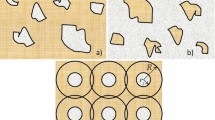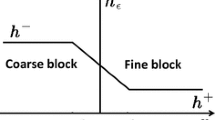Abstract
We address the two-scale homogenization of the Navier–Stokes and Cahn–Hilliard equations in the case of a weak miscibility of a two-component fluid. To this end a notion of the miscibility strength is formulated on the basis of a correlation between the upscaling parameter and the surface tension. As a result, a two-scale model is derived. Macro-equations turn out to be a generalization of the Darcy law enjoying cross-coupling permeability tensors. It implies that the Darcy velocity of each phase depends on pressure gradients of both phases. Micro-equations serve for determination both of the permeability tensors and the capillary pressure. An example is constructed by analytical tools to describe capillary displacement of oil by mixture of water with carbon dioxide in a system of hydrophobic parallel channels.



Similar content being viewed by others
References
Abels, H. Double obstacle limit for a Navier-Stokes/Cahn-Hilliard system. In Progress in Nonlinear Differential Equations and Their Applications 43, 1-20, Springer 2011
Amirat, Y., Shelukhin, V.V.: Homogenization of equations for miscible fluids. J. Appl. Mechan. Techn. Phys. 62(4), 692–700 (2021)
Anderson, D.M., McFadden, G.B., Wheeler, A.A.: Diffuse-interface methods in fluid mechanics. Ann. Rev. Fluid Mechan. 30, 139–165 (1998)
Arbogas, T., Douglas, J., Jr., Hornung, U.: Derivation of the double porosity model of single phase flow via homogenization theory, SIAM. J. Math. Anal. 21, 823–836 (1990). https://doi.org/10.1137/0521046
Arbogast, T., Lehr, H.L.: Homogenization of a Darcy-stokes system modeling vuggy porous media. Comput. Geosci. 10, 291–302 (2006). https://doi.org/10.1007/s10596-006-9024-8
Auriault, J.L., Lebaigue, O., Bonnet, G.: Dynamics of two immiscible fluids flowing through deformable porous media. Transp. Porous Media 4(2), 105–128 (1989)
Avraam, D.G., Payatakes, A.C.: Flow regimes and relative permeabilities during steady-state two-phase flow in porous media. J. Fluid Mechan. 293, 207–236 (1995)
Balashov, V.A.: Dissipative spatial discretization of a phase field model of mul-tiphase multicomponent isothermal fluid flow. Comput. Math. Appl. 90, 112–124 (2021)
Banas, L., Mahato, H.S.: Homogenization of evolutionary Stokes-Cahn-Hilliard equations for two-phase porous media flow. Asympt. Anal. 105(1–2), 77–95 (2017)
Bear, J.: Dynamics of Fluids in Porous Media. Elsevier, New York (1972)
Bear J., Zaslavsky D., Irmay S.(ed.), Physical principles of water percolation and seepage, Unesco, 1968
Bensoussan, A., Lions, J.-L., Papanicolau, G.: Asymptotic analysis for periodic structures. North-holland, Amsterdam (1978)
Blunt, M.J.: Multiphase flow in permeable media: A Pore-scale perspective. Cambridge University Press, Cambridge (2017)
Daly, K.R., Roose, T.: Homogenization of two fluid flow in porous media. Proc. R. Soc. A 471, 20140564 (2015)
Dullien, F.: Porous media-fluid transport and pore structure academic. Academic press, San Diego (1992)
Hassanizadeh, M., Gray, W.G.: General conservation equations for multi-phase systems: 3, constitutive theory for porous media flow,. Adv. Water Resour. 3(1), 25–40 (1980)
Helmig, R.: Multiphase flow and transport processes in the subsurface. Springer, Berlin (1997)
Hilfer, R.: Macroscopic equations of motion for two-phase flow in porous media. Phys. Rev. E 58, 2090–2096 (1998)
Hornung, U.: Homogenization and porous media. Springer, New York, NY (1996)
Keller J., Nonlinear Partial Differential Equations in Engineering and Applied Science, Proceedings of the Conference, Kingston, R.I., June 4-8, 1979 (Marcel Dekker, Inc., New York, 1980), 429-443
Kou, J., Sun, S.: Thermodynamically consistent modeling and simulation of multi-component two-phase flow with partial miscibility. Comput. Methods Appl. Mechan. Eng. 331, 623–649 (2018)
Landau, L.D., Lifshitz, E.M.: Volume 6 of course of theoretical physics, Fluid mechanics. Pergamon Press, Oxford-Elmsford, New York (1987)
Lasseux, D., Valdés-Parada, F., Bellet, F.: Macroscopic model for unsteady flow in porous media. J. Fluid Mechan. 862, 283–311 (2019)
Lipton, R., Avellaneda, M.: A Darcy law for slow viscous flow past a stationary array of bubbles. Proc. Roy. Soc. Edinburgh 2, 203–222 (1989)
Metzger, S., Knabner, P.: Homogenization of two-phase flow in porous media. From pore to Darcy scale: A Phase-field approach. Multiscale Model. Simul. 19(1), 320–343 (2021)
Picchi, D., Battiato, I.: The impact of pore-scale flow regimes on upscaling of immiscible two-phase flow in porous media. Water Resour. Res. 54, 6683–6707 (2018)
Sanchez-Palencia, E.: Non-homogeneous media and vibration theory. Lecture notes in Phys, Springer, New York (1980)
Shelukhin, V., Perepelitsa, M.: On global solutions of a boundary-value problem for the one-dimensional Buckley-Leverett equations. J. Appl. Anal. 73(3–4), 325–344 (1999)
Starovoitov, V.N.: Model of the motion of a two-component liquid with allowance of capillary forces. J. Appl. Mech. Tech. Phys. 35(6), 891–897 (1994)
Trangenstein, J.: In: Allen, M., Behie, G., Trangenstein, J. (eds.) Multiphase Flow in Porous Media, p. 87. Springer-Verlag, Berlin (1988)
Whitaker, S.: Flow in porous media II: the governing equations for immiscible, two-phase flow. Transp. Porous Media 1, 105–125 (1986)
Whitaker, S.: Flow in porous media I: a theoretical derivation of Darcy’s law. Transp. Porous Media 1, 3–25 (1986)
Whitaker, S.: The method of averaging. Kluwer Academic, Norwell, MA (1999)
Xu, X., Wang, X.: Non-Darcy behavior of two-phase channel flow. Phys. Rev. E 90, 023010 (2014)
Acknowledgements
The work of the second and the third authors was supported by the State Assignment of the Russian Ministry of Science and Higher Education entitled “Modern models of hydrodynamics for environmental management, industrial systems and polar mechanics” (2024-26) (Govt. contract code: FZMW-2024-0003).
Funding
Funding information is not applicable.
Author information
Authors and Affiliations
Corresponding author
Ethics declarations
Conflict of interest
The authors declare no Conflict of interest.
Ethics approval
Not applicable.
Additional information
Publisher's Note
Springer Nature remains neutral with regard to jurisdictional claims in published maps and institutional affiliations.
Appendices
Appendix A Evolution of a droplet
All our numerical calculations for the Cahn–Hilliard equations are performed with the use of FreeFem++. To tackle nonlinearity, the Newton-Raphson iteration procedure is employed. As for the temporal discretization, an explicit in time method is applied with the time step equal to \(\mathrm 5\cdot\,10^{-3}\). The code was validated by applying it to the problem concerning the evolution of a droplet initially located in the center of the domain and having the form of a quadrat, i.e., \(\varphi = 1\) inside the quadrat and \(\varphi = 0\) outside it when \(t = 0\) Kou and Sun (2018). The boundary of the droplet is slightly “blurred". It is clear that the droplet ultimately should take the spherical form Balashov (2021) due to gradient of chemical potential. In the domain
we consider the following initial boundary value problem
where
We use the following data:
Calculations reveal that the initial quadrat becomes a circle (Fig. 4).
Appendix B
Here, we prove that equality (12) holds. Indeed, due to equation (8), one can write the derivative of energy as follows:
By equation (7), we conclude that
On the other hand, if we multiply equation (8) by \(\Delta \varphi\) and integrate by parts, we get the equality
The last integral in the above formula can be written as
Summation of equalities (B1) and (B2) results in formula (12).
Appendix C
Here, we derive some formulas useful in homogenization. Our calculations are based on the following differentiation formula
Calculations reveal that
where \(y=x/\varepsilon .\) According to the theory of two-scale homogenization, the variables x and y on the right-hand side of these formulas are considered independent variables when the derivatives are substituted into the equations.
With the above calculations at hands, equation (6) becomes
with
Clearly, one can write this equation as an equality of two expansions with respect to \(\varepsilon\).
Appendix D
Here, we give details of construction of a one-dimensional solution \(S(\tau ,x)\), \(\Pi _1(\tau ,x)\), \(\Pi _2(\tau ,x)\) to the system (42)-(45), where \(S=S_2\).
For such a one-dimensional flow, the equation \(\text {div}(\textbf{v}^{(1)}+\textbf{v}^{(2)})=0\) becomes
Passing to pressures, we obtain that
where
Due to (70) and (71), equation (D3) is equivalent to
The macro-equation (42) for \(S=S_2\) can be formulated as
Due to (70) and (71), equation (D5) admits the form
It follows from (D4) that equation (D6) becomes
This macro-equation describes displacement with a discontinuity front, when at the initial moment of time on the interval \(0<x<1\), the function S takes the value \(S_+\), \(0\le S_+\le 1\), and the boundary condition \(S=S_-\), \(S_+\le S_-\le 1\) is kept at the input boundary \(x=0\):
The functions \(S,\Pi _1,\Pi _2\) satisfy the following macro-problem
where the notation \(f(\cdot )\) implies that the function f depends not only on the macro-variables \((x,\tau )\), but on the micro-equations (55)-(59) as well. The fast time \(t'\) in equations (D8)-(D10) is set to be equal to the stabilization time \(t'_*(x)\). Due to the properties (60), the macro-equations admit a solution given by constants:
and
We look for a piecewise continuous solution of equations (D8)-(D10) with the discontinuity front \(x=\sigma (t)\). Equation (D9) is equivalent to the system of equations (D4) and (D7). We introduce the jump \([S]_{\sigma }\) of the discontinuous function S(x) at the line of discontinuity \(x=\sigma (\tau )\):
By the Hugoniot condition Shelukhin and Perepelitsa (1999)
it results from the scalar conservation law (D7) that the front satisfies the equation
Following the method of Shelukhin and Perepelitsa (1999) we introduce the self-similar variable \(\zeta =x/\sigma (\tau )\) and look for a solution in the form of a centered wave \(S(x,\tau )=S(\zeta )\) behind the front. In the domain \(0<x<\sigma (\tau )\), equation (D7) becomes
The equality \(S=\text {const}=S_-\) holds behind the front. Before the front, i.e., in the domain \(x>\sigma (\tau )\), we assume that \(S=\text {const}=S_+\).
To simplify calculations, the data \(\Pi _i^0, \Pi _i^1\) (\(i=1,2\)) in the boundary conditions
are assumed to satisfy the special restrictions
We integrate equations (D4) over the intervals \(0<x<\sigma\) and \(\sigma<x<1\) paying attention that the reduced pressures \(\Pi _1\) and \(\Pi _2\) are continuous. As a result, we obtain the equalities
where \(\Pi _i^\sigma\) is the value of \(\Pi _i\) at \(x=\sigma\). It follows from (D13) that
Let us calculate the jumps of the capillary curve (D10):
Taking into account formula (D14), we arrive at the following equation for the front velocity:
This formula coincides with (77).
The assumption that the phase velocities behind the front and ahead of the front do not depend on the spatial coordinate makes it possible to determine these velocities. Indeed, applying (70) and (71) we conclude that
We integrate equation (D16) for \(v_1^{(1)}\) over the intervals \(0<x<\sigma\) and \(\sigma<x<1\), keeping in mind formula (D14). As a result, we obtain
Hence,
Because of (D4), one can derive from (D16) and (D17) the equality \(S_2 v_1^{(1)}=\) \(S_1 v_1^{(2)}\). It implies that
Formulas (D18) and (D19) are equivalent.
The saturation is given by the formula
Let us determine the reduced pressures. Integration of equation (D4) over the interval \(0<x<\sigma\), taking into account the boundary conditions (D11) leads to equalities
which allow to find \(\Pi _i\) on the interval \(0<x<\sigma\). As for the interval \(\sigma<x<1\), these pressures solve the system
Rights and permissions
Springer Nature or its licensor (e.g. a society or other partner) holds exclusive rights to this article under a publishing agreement with the author(s) or other rightsholder(s); author self-archiving of the accepted manuscript version of this article is solely governed by the terms of such publishing agreement and applicable law.
About this article
Cite this article
Amirat, Y., Shelukhin, V. & Trusov, K. Flows of Two Slightly Miscible Fluids in Porous Media: Two-Scale Numerical Modeling. Transp Porous Med 151, 1423–1452 (2024). https://doi.org/10.1007/s11242-024-02080-1
Received:
Accepted:
Published:
Issue Date:
DOI: https://doi.org/10.1007/s11242-024-02080-1





